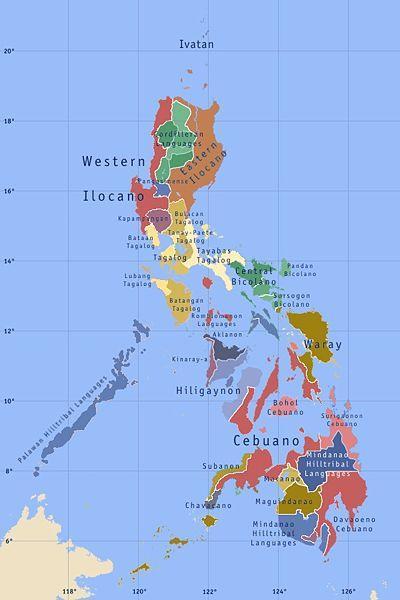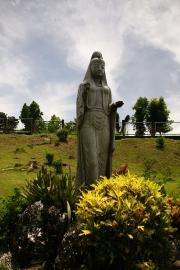
In the Philippines, there are between 120 and 175 languages, depending on the method of classification. Four languages no longer have any known speakers. Almost all the Philippine languages belong to the Austronesian language family. Of all of these languages, only 2 are considered official in the country while (as of 2010) about 12 are considered official auxiliary.
According to Ethnologue, a total of 171 native languages are spoken in the country. Except for English, Spanish, Hokkien (Lan-nang), Cantonese, Mandarin, and Chavacano, all of the languages belong to the Malayo-Polynesian language family.
There are 13 indigenous languages with at least one million native speakers: Tagalog, Cebuano, Ilokano, Hiligaynon, Waray-Waray, Kapampangan, Bikol, Albay Bikol, Pangasinan, Maranao, Maguindanao, Kinaray-a, and Tausug. One or more of these is spoken natively by more than 90% of the population.
A Philippine language family identified by Robert Blust includes languages of north Sulawesi and the Yami language of Taiwan, but excludes the Sama–Bajaw languages of the Sulu Archipelago as well as a couple North Bornean languages spoken in southern Palawan.
Philippine languages are often referred to by Filipinos as dialects, partly as a relic of the inaccurate vocabulary used in literature during the American period (1898–1946). While there are indeed many hundreds of dialects in the Philippines, they represent variations of no fewer than 120 distinct languages, and many of these languages maintain greater differences than those between established European languages like French and Spanish.
Some of the major languages of the Philippines are discussed below:
Filipino
Filipino language is a prestige register of Tagalog language and the official language of the Philippines. Tagalog is the language of about one-third population in the country and inspite for being the national language; only 55% of the Filipinos speak the language. It is centered on Manila but is spoken in varying degrees nationwide.
There is no common language in the Philippines when Spanish arrived at 16th century. The three major languages are Tagalog, Visayan and Ilocano. These three became the major contenders on the first national assembly in the Philippines on November 12, 1937. It approved a law creating a National language Institute to make a study and survey of each existing native language, hoping to choose a language for a standardized national language.
On 14 July 1936, the Surián ng Wikáng Pambansâ (National Language Institute) selected Tagalog as the basis of the Wikáng Pambansâ (National Language) based on the following factors:
1. Tagalog is widely spoken and is the most understood in all the Philippine Regions;
2. It is not divided into smaller daughter languages, such as Visayan or Bikol are;
3. Its literary tradition is the richest, most developed and extensive (mirroring that of the Tuscan language vis-à-vis Italian). More books are written in Tagalog than in any other autochthonous Philippine language, but this is mainly by virtue of law and privilege;
4. Tagalog has always been the language of Manila, the political and economic centre of the Philippines during the Spanish and American Eras;
5. Tagalog was the language of the 1896 Revolution and the Katipunan.
Along with English, Filipino is one of the two official languages in the Philippines and constitutionally designated as the national language of the country.
Cebuano
Cebuano language is the native language widely used not only in Cebu Island but also by most central and southern Philippines. Mostly, it referred to by most of its speakers as Binisaya (or Visayan in English).
Cebuano is an Austronesian language which is derived from the island of Cebu where the prestige dialect is spoken. It has the largest native language speaking population of the Philippines despite not being taught formally in schools and universities.
Cebuano speakers can be easily distinguished from speakers of other Visayan languages by the use of the word sa ("of") instead of sang (in Hiligaynon) orhan (in Waray).
Ilocano
Ilokano or Ilocano is the third most-spoken language of the Republic of the Philippines. As Austronesian language that is related to such languages as Indonesian, Malay, Fijian, Maori, Hawaiian, Malagasy, Samoan, Tahitian, Chamorro, Tetum, and Paiwan. Ilocano occupy the narrow, barren strip of land in the northwestern tip of Luzon, squeezed in between the inhospitable Cordillera mountain range to the east and the South China Sea to the west.
Ilocano, together with the other seven major languages (those that have at least a million speakers), was allowed to be used as a medium of instruction until the second grade. It is recognized by the Commission on the Filipino Language as one of the major languages of the Philippines.
In literature, Ilocano offers a rich background in folklore, mythology and superstition. There are many stories of good and malevolent spirits and beings. Its creation mythology centers on the giants Aran and her husband Angngalo, and Namarsua (the Creator). The epic story Biag ni Lam-ang (The Life of Lam-ang) is undoubtedly one of the few indigenous stories from the Philippines that survived colonialism, although much of it is now acculturated and shows many foreign elements in the retelling. It reflects values important to traditional Ilokano society; it is a hero’s journey steeped in courage, loyalty, pragmatism, honor, and ancestral and familial bonds.
Hiligaynon
Hiligaynon or often referred as Ilonggo is an Austronesian language widely used in Western part of the Philippines. It is concentrated in the provinces of Iloilo, Negros Occidental and Capiz but is also spoken in the other provinces of the Panay Island group, including Antique, Aklan, Guimaras, and in many parts of Mindanao including Koronadal City, South Cotabato, Sultan Kudarat and parts of North Cotabato. Additional, it is spoken as a second language by Karay-a speakers in Antique, Aklanon and Malaynon in Aklan, and Capiznon in Capiz.
It is the language of Iloilo province and a member of Visayan language family. It is known from most Filipino languages for its sing-song intonation, much like Italian.
Waray-waray
The name comes from the word often heard by non-speakers, "waray" (meaning "none", "nothing" or "not"). Commonly referred to as Winaray or Lineyte-Samarnon, is a language spoken in the provinces of Samar, Northern Samar, Eastern Samar, and in some parts of the Leyte and Biliran in the Philippines. The Waray-Waray languages are spoken by the Waray people of Samar Island and in most parts of Leyte and in some parts of Biliran Island shows dialectal variations. Dialects are spoken in some parts of Masbate, particularly on the island of Ticao which is adjacent to Samar Island.
Waray language also belongs to Visayan language family and is related to Cebuano and Hiligaynon.
Kapampangan
Kapampangan is the language spoken in the province of Pampanga, the southern half of the province of Tarlac and the northern portion of the province of Bataan. It is also understood in some barangays of Bulacan and Nueva Ecija and by the Aitas or Aeta of Zambales.
The word Kapampangan is derived from the rootword pampáng which means "river bank." Historically, this language was used in what was before the Kingdom of Luzon, ruled by the Lakans. In the 18th century, two books were written by Fr. Diego Bergaño. He authored Vocabulario de la lengua Pampanga and Arte de la lengua Pampanga. The Kapampangan Language produced two literary giants in the 19th century. Father Anselmo Fajardo was noted for his works Gonzalo de Córdova and Comedia Heróica de la Conquista de Granada. Another writer, Juan Crisostomo Soto, was noted for writing many plays. He authored Alang Dios in 1901. The Kapampangan poetical joust "Crissotan" was coined by his fellow literary genius Nobel Prize nominee for peace and literature in the 50's, Amado Yuzon to immortalize his contribution to Pampanga's Literature.
Bikol
The Bikol languages are a group of Central Philippine languages spoken mostly on the Bicol Peninsula of the island of Luzon and also parts of Catanduanes and Burias Islands and Masbate Province. There is a dialect variety between the Visayan languages and the Bikol languages; the two together are called the Bisakol languages. Bikol languages are classified under the Central Philippine language family of which Tagalog and the Visayan languages are a part of. The four groups are Northern Bikol, Southern Bikol, Northern Catanduanes and Bisakol.
Pangasinan
The Pangasinan language is one of the major languages in the Philippines. It belongs to the Malayo-Polynesian languages branch of the Austronesian languages family. The language which is called "Pangasinese" is the primary language in the province of Pangasinan, located on the west central area of the island of Luzon along the Lingayen Gulf. It is similar to Tagalog and Ilocano languages and very closely related to the Ibaloi language spoken in the neighboring province of Benguet and Baguio City, located north of Pangasinan.
Maranao
Maranao is a term used for the people of Lanao, a predominantly Muslim region in the Philippines island of Mindanao. Maranao is an Austronesian language spoken by the Maranao people in the provinces of Lanao del Norte and Lanao del Sur in the Philippines.
Maguindanao
Maguindanao is an Ausronesian language spoken by majority of the population of Maguindanao province in the Philippines. It is also used in different parts of Mindanao such as the cities of Zamboanga, Davao, and General Santos, and the provinces of North Cotabato, Sultan Kudarat, South Cotabato, Sarangani, Zamboanga del Sur, Zamboanga Sibugay, as well as Metro Manila.
Tausug
Tausug is a language spoken in the province of Sulu in the Philippines, in Malaysia, and in Indonesia by the Tausug people. It is widely spoken in the Sulu Archipelago (Basilan, Sulu and Tawi-Tawi), Zamboanga Peninsula (Zamboanga del Norte, Zamboanga Sibugay, Zamboanga del Sur, and Zamboanga City), Southern Palawan and in Sabah (Malaysia). It is very closely related to the Butuanon language of northeastern Mindanao. The name of the language in Tausug is Bahasa Sug which means language of the Sug where Sug is taken to mean the area in which it is spoken (i.e. Sulu). The word Tausug is the name used colloquially where Tau means "person," and hence Tausug means person of Sug (Sulu).
Kinaray-a
Kinaray-a is an Austronesian language belongs to the Visayan family spoken mainly in Antique Province in the Philippines. It is also spoken in Iloilo province, the south of Capiz province, and certain villages in Mindanao. Kinaray-a came from the word "iraya", equivalent to "ilaya" in Tagalog, which refers to a group of people residing in the mountain areas of the province. However, Kinaray-a does not necessarily refer to the way or language spoken by the highlanders of Panay Island. Speakers of this language are called, "Karay-a." Kinaray-a is also spoken in most parts of Iloilo and southern Capiz together with Hiligaynon. Most towns of these areas speak Kinaray-a while Hiligaynon is mostly spoken in Iloilo City itself. Due to regional proximity, media and television stations, Kinaray-a speakers can understand Hiligaynon speakers. However, only Hiligaynon speakers who reside in Kinaray-a speaking areas can understand the language. Those who come from other areas, like Negros, have difficulty in understanding the language, if they can at all.
It is a misconception among some Hiligaynon speakers that Kinaray-a is a dialect of Hiligaynon; the reality is that the two belong to two different, but related, language subgroups. However, some of the Kinaray-a speakers have also Hiligaynon as their second language; that is why Cebuanos assumed that Kinaray-a words are Hiligaynon ones. In some extent, there is an intermediate dialect of Hiligaynon and Kinaray-a being spoken in Mindanao.










